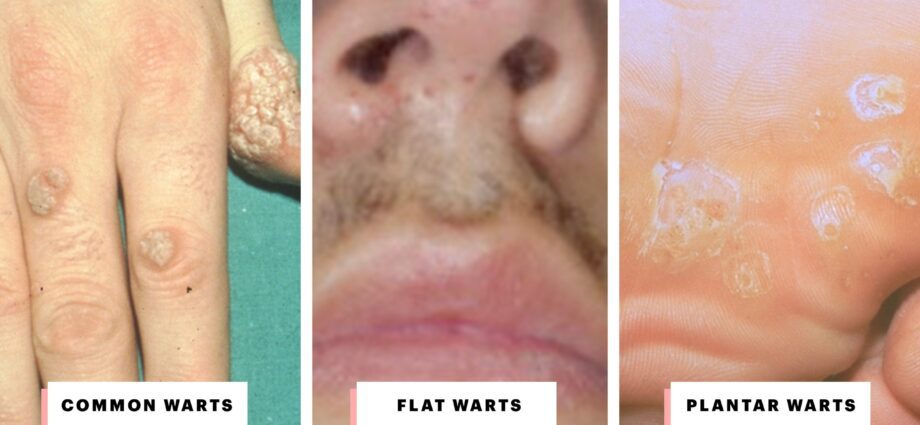Common and plantar warts
The warts are small rough growths benign, well demarcated, that form in the epidermis (the outer layer of the skin). They are usually a few millimeters in diameter, but can be larger. They are the result of an infection caused by a virus of the family papillomavirus humans (HPV), and can be contagious. They are most often painless and do not necessarily require treatment. Children and adolescents are the most likely to be affected.
Warts most often appear on the fingers or feet, but it can also be found on the face, back or other parts of the body (elbows, knees). They can be isolated or form clusters of several warts grouped together.
Prevalence
It is estimated that the warts affect 7-10% of the general population23. A study carried out in a Dutch primary school in 2009, however, found that a third of children and had one or more warts, localized mainly on the feet or hands24.
Types
There are several types of warts, depending on the type of papillomavirus involved. Their appearance also varies depending on where they are located. Here are the most common shapes:
- Common wart : this wart takes the appearance of a hard and rough dome of flesh or grayish color. Usually, it appears on its own. It can form especially on the knees, elbows and feet (toes), but more often on the hands and fingers. Rarely painful (except when located near or under the fingernails), however, it can be bothersome.
- Plantar wart : as its name suggests, the plantar wart is located on the sole of the foot. It can go unnoticed for a while. If you look closely, you can still see a rough nodule. Plantar wart can be painful due to the pressure exerted by the weight of the body. It may seem like it is deep, but it is always located in the outer layer of the skin, the epidermis.
- The other types: these include, among others, filiform warts (located on the eyelids and around the mouth in children), flat warts (usually grouped on the face, backs of hands and wrists), myrmecia (on the sole of the foot, with black dots), mosaic warts (under the feet) and finger warts (often on the scalp). Digitized warts result from the stacking of several warts, which forms a kind of tiny “cauliflower”.
The genital warts or condylomas are a special case. They are caused by a different type of HPV and can pose health risks (for example, in women, condyloma increases the risk of cervical cancer). Moreover, they are treated differently. It will not be discussed in this sheet. For more information, see the Condyloma sheet. |
Contagion
La contamination can be done directly (skin to skin) or indirectly (by objects that have been in contact with infected skin, such as socks or shoes). The wet soils swimming pools, public showers, beaches and sports activity centers are particularly conducive to the transmission of plantar warts. In addition, some HPVs can survive for more than 7 days on a dry surface.
Le virus gets under the skin, through a small crack or a wound sometimes invisible to the naked eye. If the virus is not neutralized by the immune system, it triggers cells to multiply in a specific location. Exposure to the virus does not automatically cause warts to appear, because everyone’s immune system reacts differently and may be more or less effective in fighting this virus.
On average, it takes 2 to 6 months between exposure to the virus and the appearance of warts. This is called the period ofincubation. However, some warts can remain “dormant” for years.
In an infected person, warts can also spread from one part of the body to another. They are said to be self-contagious. You should avoid scratching or bleeding a wart, as this increases the risk of it spreading.
|
Evolution
Most warts disappear without treatment after a few months. Several studies have shown that two-thirds of warts go away without treatment in less than 2 years1. However, in some people, they can take on a character chronic.
Complications
Despite their uninviting look, the warts are generally not serious. Even when scratched, it is rare for them to become infected, but it is recommended not to do so. In addition, unless it is a plantar wart or it is located near a fingernail, they are usually painless.
That said, some complications are still possible. The onset of one or more of the following symptoms should prompt see a doctor.
- A wart that persists, multiplies or reappears, despite home treatments;
- A painful wart;
- A wart located under the nail or deforming the nail;
- Bleeding;
- A suspicious appearance (in exceptional cases, a wart may turn out to be malignant). Some skin cancers can also be mistakenly thought of as warts;
- Signs of infection, such as redness around the wart;
- Spread to other parts of the body;
- Back pain or leg pain caused by a painful plantar wart (limping or improper positioning of the feet when walking);
- Discomfort related to the location of the wart.
Diagnostic
To ensure that it is indeed a wart, the doctor first inspects the lesion. Sometimes he uses a scalpel to scratch it: if it is bleeding or if there are black dots present, it indicates the presence of a wart. Very rarely, the appearance of the lesion casts doubt on the diagnostic. The doctor can then proceed to a biopsy, to make sure it is not cancer.










